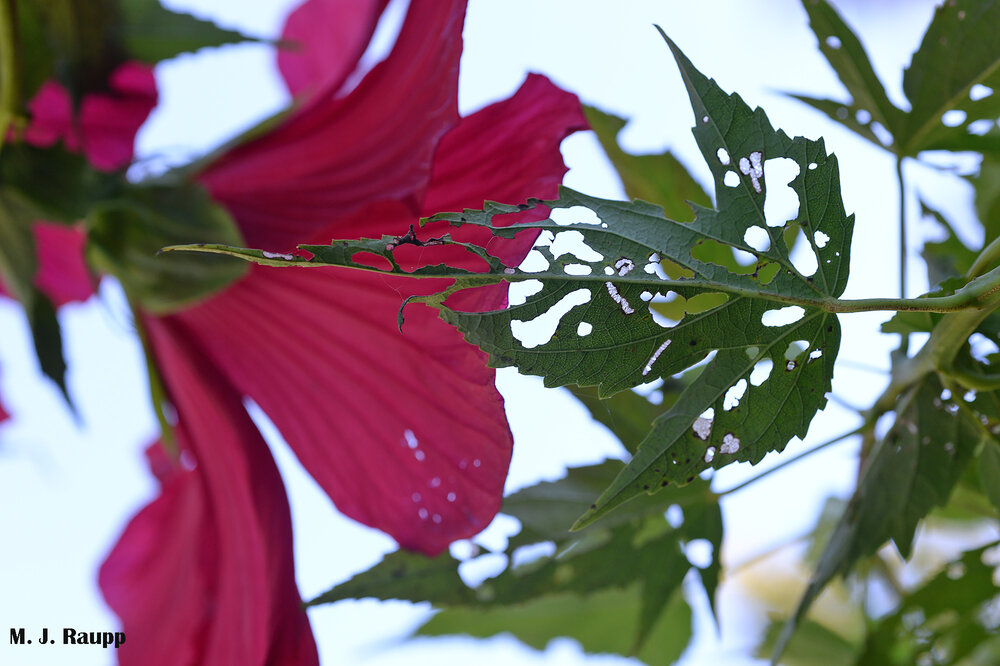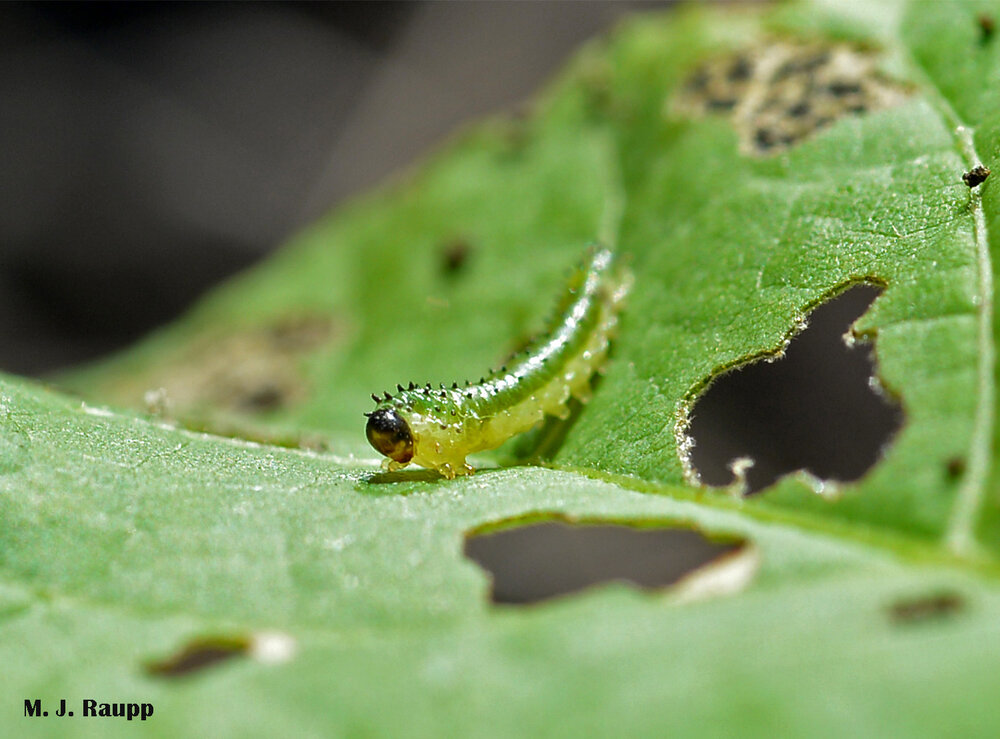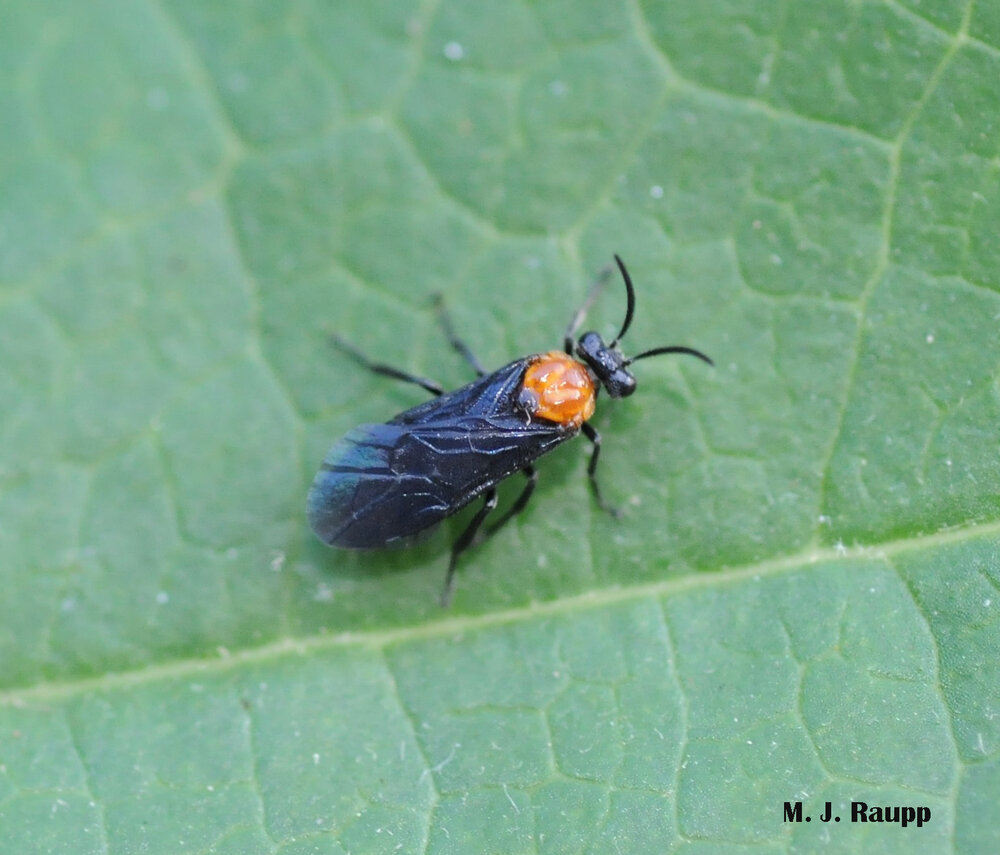Mallow munchers: Mallow sawfly, a.k.a. Hibiscus sawfly, Atomacera decepta

Beautiful hibiscuses are wonderful native plants for raingardens and important sources of nectar and pollen for many beneficial insects. However, sneaky mallow sawfly larvae can reduce leaves to tatters.
Members of the mallow family, Malvaceae, are some of the most important crops on earth. Included in this wonderful clan are cotton, okra, and cacao. In addition to providing fibers we wear and the raw material for chocolate, members of the Malvaceae are valued throughout the world for their medicinal properties and as herbal remedies for a variety of afflictions. Mallows are some of the most beautiful flowering herbaceous and woody plants worldwide. In Maryland, hollyhocks, rose of Sharon, and various annual and perennial hibiscus dazzle our gardens. Common marsh-mallow adds a splash of color to swales and drainage channels along our roadways in summer.

Stout spines adorn the back of the mallow sawfly larva.
While wandering along a lakefront trail in Columbia, Maryland, I spied a raingarden filled with ginormous red-blossomed hibiscus. While the blossoms were spectacular, many of the hibiscus leaves were severely tattered. On the shore of a nearby lake hosting patches of marsh-mallow, I discovered the culprits behind this malvaceous mischief, several larvae of the mallow sawfly feasting on tender leaves of small plants. Although caterpillar-like in appearance, the mallow sawfly is a rogue member of the bee and wasp clan, the Hymenoptera. This primitive branch of Hymenoptera contains mostly herbivores, plant feeders that dine on a wide variety of grasses, grains, herbaceous plants, shrubs, and trees.
At first mallow sawflies may go undetected on hibiscus and other members of the mallow family. Holes in leaves and leaves in tatters are often diagnostic clues for this pest. Closer inspection of tender leaves on this small marsh-mallow revealed several mallow sawfly larvae. Nibble by nibble they remove leaf tissue and eventually shred leaves often leaving nothing behind but leaf veins.

Female mallow sawflies are striking insects with dark wings and a vivid orange thorax.
The female mallow sawfly begins her assault on a mallow by using a saw-like egg laying appendage called an ovipositor to carve small slits in the leaf’s surface. Each egg-slits receives an egg. Tiny leaf- munchers issue from the eggs, feed, and pass through six larval stages. Their feeding first creates tiny holes in leaves called shot holes, but as they grow, so too does their appetite and soon large hunks of tender tissue disappear down their gullets, leaving behind only shredded leaves and skeletal remains consisting of tough leaf veins. Once their feasting is finished, larvae move to the base of the plant to pupate on lower stems and in the soil. From the pupae emerge fresh adult wasps ready to find a mate, lay eggs, and resume the assault on mallow. In southern states there may be as many as six generations each year, but fewer occur in Maryland. Fortunately, mallow sawflies never really developed a sincere taste for cotton, okra, or rose of Sharon, but hollyhocks, ornamental mallows, and marsh-mallow are definitely on the menu. By midsummer, leaves of these beauties may be shredded.
So, what can you do to prevent a plague of these tiny tormentors? Several varieties of hibiscuss, including Hibiscus acetosella, H. aculeatus, and H. grandiflora, are noted to be resistant to this pest. Another strategy to foil the sawfly is to inspect your hibiscus on a weekly basis and simply pluck larvae from the plant and toss them in the compost where they will become food for the ravenous horde of predatory invertebrates dwelling there. While insecticidal sprays are available to kill sawfly larvae, high visitation rates of pollinators and other beneficial insects to the hibiscus flowers make this a sketchy option.
Acknowledgements
Two excellent articles, “Evaluation of Twelve Genotypes of Hibiscus for Resistance to Hibiscus Sawfly, Atomacera decepta Rohwer (Hymenoptera: Argidae)” by David W. Boyd, Jr. and Christopher L. Cheatham, and “The sawfly Atomacera decepta, a pest of Hibiscus” by H. H. Tippins were used to prepare this episode. We thank Karin Burghardt, whose keen observations of mallow sawflies served as the inspiration for this episode.
This post appeared first on Bug of the Week